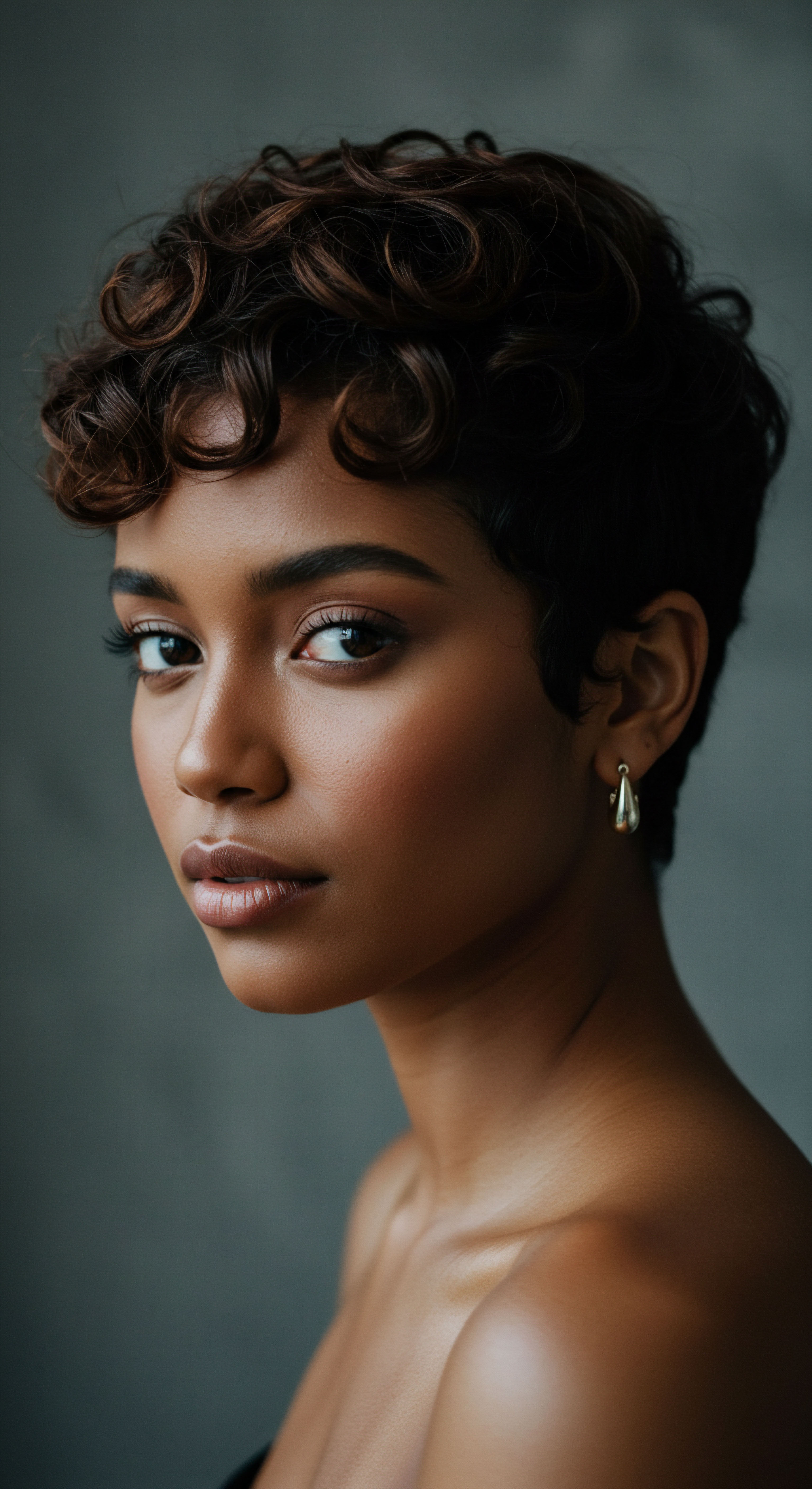
Roots
Consider the intricate dance of life within each strand, a testament to heritage and the silent wisdom passed through generations. African hair, with its remarkable coil patterns, holds stories whispered from ancestral lands, a unique expression of identity. To truly grasp the scientific principles supporting traditional African hair care, we must first gaze upon the very foundation of these strands, understanding their distinctive structure and inherent properties. This journey begins not with complicated theories, but with a gentle observation of what makes coily hair truly distinct, laying bare the biological blueprint that informs centuries of gentle, knowing care.
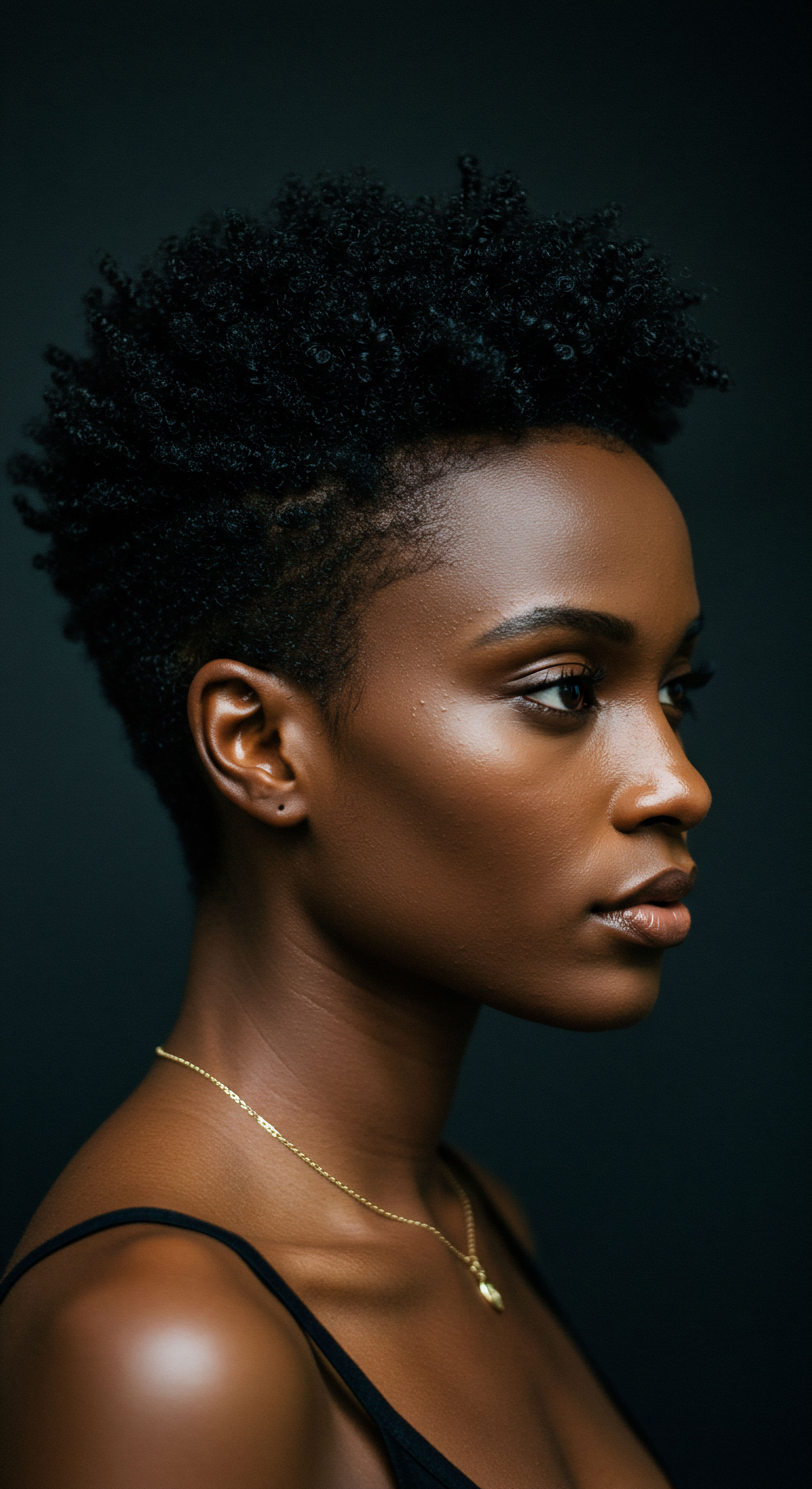
Hair Anatomy and Physiology Specific to Textured Hair
Hair, at its most fundamental, comprises keratin, a protein. Yet, the way this protein assembles, and the shape of the follicle from which it emerges, dictates the outward appearance of each strand. For African hair, the follicle typically presents as an Elliptical or Flattened Shape, not round.
This distinct follicular form causes the hair shaft to grow in a helical, spiral, or zigzag pattern, resulting in the characteristic coils and kinks. This coiled morphology carries several implications for the hair’s physical and chemical behavior.
One primary consequence of this coiled structure is the uneven distribution of the scalp’s natural oils, known as sebum. On straight hair, sebum can easily glide down the shaft, providing a natural protective coating. For coily hair, the twists and turns present physical barriers, making it difficult for sebum to travel from root to tip. This leads to the perception of dryness along the hair shaft, even if the scalp itself produces sufficient oil.
The hair’s cuticle, the outermost protective layer, also behaves differently. In coily hair, these cuticle cells are often smaller and more tightly packed, yet at each bend or curve, there exist Pressure Points where the cuticle is slightly lifted or flattened, making the hair more prone to breakage.
Beyond surface characteristics, the internal composition also shows distinctions. African hair exhibits a higher overall lipid content compared to European and Asian hair, with quantities estimated to be 2.5 to 3.2 times higher than European and Asian hair, respectively. This includes a greater internal lipid content, about 1.7 times higher, along with higher quantities of free fatty acids, sterol, and polar lipids. While lipids contribute to hair integrity and hydrophobicity, the specific arrangement and higher concentration of these lipids in African hair may influence the keratin structure, potentially leading to a higher disorganization of the keratin structure, which returns to its typical packing arrangement after lipid removal.
The elliptical shape of African hair follicles dictates its coiled form, impacting sebum distribution and cuticle integrity.
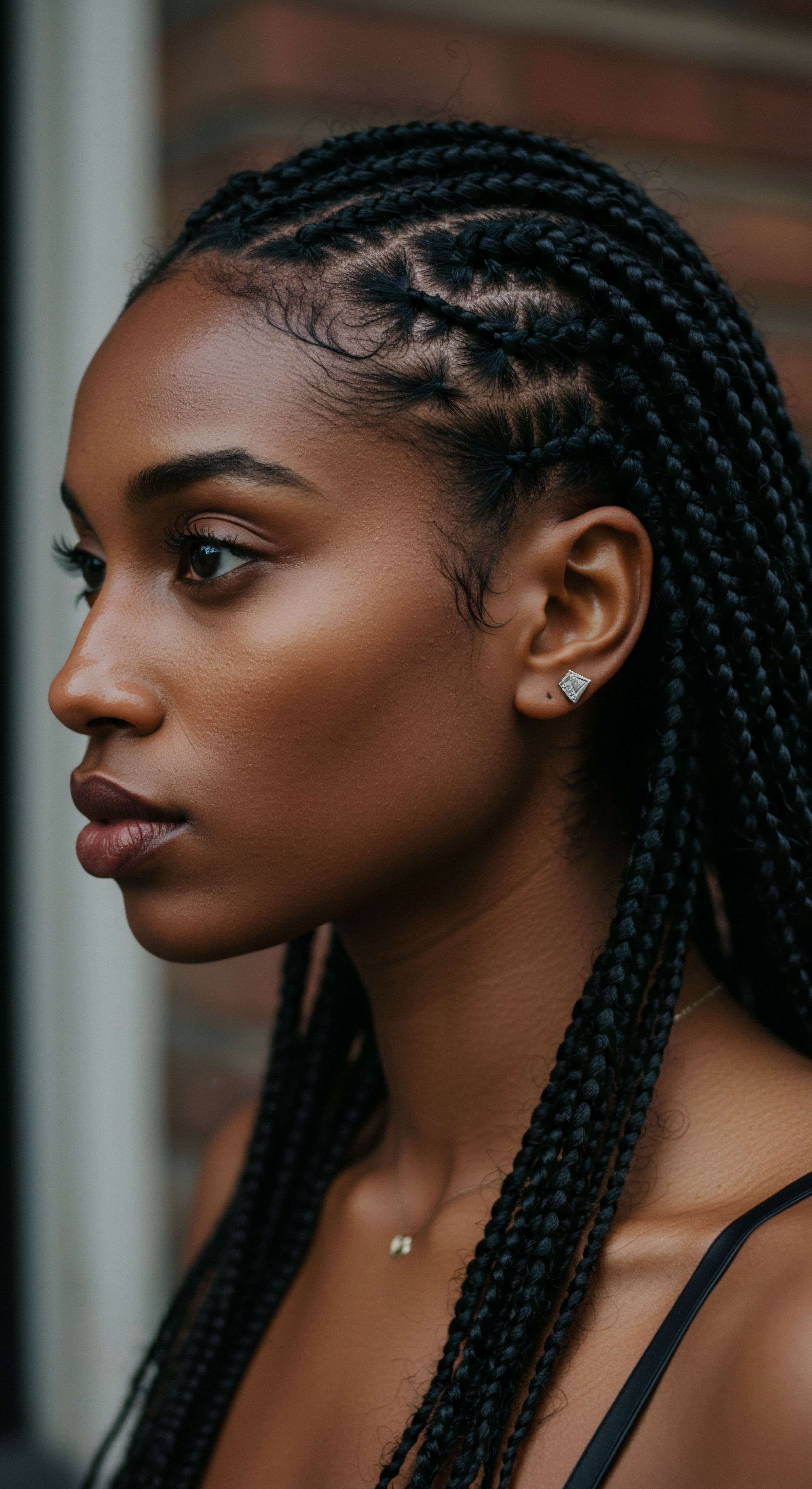
How Does Hair Classification Aid Care?
Hair classification systems, such as the Andre Walker system, categorize hair into types (1, 2, 3, 4) with subcategories (A, B, C), providing a common language to describe curl patterns. While not without its limitations, this system helps individuals identify general characteristics of their hair, informing product choices and care practices. Type 4 hair, which encompasses many African hair coil patterns, is recognized for its tight coils, tendency toward dryness, and fragility. Understanding these classifications helps in selecting products and techniques that respect the hair’s inherent properties, rather than working against them.
- Type 4A ❉ Displays tight, defined coils resembling small ringlets, generally retaining moisture well but remaining delicate.
- Type 4B ❉ Characterized by Z-shaped curls with less definition, often appearing fluffy and prone to shrinkage.
- Type 4C ❉ Possesses the tightest coil pattern, with minimal definition and significant shrinkage, making it the most fragile type.

The Essential Lexicon of Textured Hair
A shared vocabulary aids greatly in discussing and understanding textured hair. Terms like “porosity,” “shrinkage,” and “hygral fatigue” are more than mere buzzwords; they represent scientific concepts critical to optimal care. Porosity refers to the hair’s ability to absorb and retain moisture.
Coily hair often exhibits high porosity, meaning its cuticle layers, while sometimes tightly packed, can lift easily, allowing moisture to enter quickly but also escape just as rapidly. This rapid moisture loss necessitates specific care strategies.
Shrinkage describes the apparent reduction in hair length as it dries, a natural characteristic of coily hair due to its spring-like structure. While hair grows at a similar rate across ethnicities (approximately 0.9 cm per month for African hair, compared to 1.2 cm for Caucasian and 1.4 cm for Asian hair), the coiling effect makes growth appear slower. This physical characteristic requires careful handling to prevent breakage during detangling and styling.
Hygral Fatigue, or moisture overload, occurs when hair undergoes repeated cycles of excessive water absorption and dehydration, weakening the internal protein bonds and leading to limp, mushy, or overly elastic strands. This condition is particularly relevant for highly porous, coily hair, which can absorb large amounts of water, and highlights the need for balanced moisture and protein treatments.

Hair Growth Cycles and Influencing Factors
All human hair follows a growth cycle consisting of three main phases ❉ anagen (growth), catagen (transition), and telogen (resting/shedding). While these phases are universal, their duration and the proportion of hairs in each phase can vary among ethnic groups. African hair generally has a shorter anagen phase compared to Asian hair, which can influence its maximum attainable length. This shorter growth phase, combined with the hair’s fragility and susceptibility to breakage, often leads to the perception that African hair does not grow as long.
Environmental factors, grooming practices, and internal health also play a role. For example, studies indicate that African hair may have a relatively slower growth rate, around 70-75% compared to other ethnicities, and a higher proportion of hair fibers in the resting (telogen) phase. Understanding these inherent biological differences helps in developing care routines that support the hair’s natural growth patterns and minimize external stressors.
| Property Follicle Shape |
| African Hair Elliptical/Flattened |
| Caucasian Hair Round/Slightly Oval |
| Asian Hair Round |
| Property Growth Rate (cm/month) |
| African Hair ~0.9 |
| Caucasian Hair ~1.2 |
| Asian Hair ~1.4 |
| Property Lipid Content (Total) |
| African Hair Highest (2.5-3.2x European/Asian) |
| Caucasian Hair Intermediate |
| Asian Hair Lowest |
| Property Cuticle Layers |
| African Hair Smaller, Tightly Packed, Pressure Points |
| Caucasian Hair Larger, More Spaced |
| Asian Hair Smooth, Well-aligned |
| Property Differences in hair properties across ethnic groups necessitate tailored care approaches. |

Ritual
Having acquainted ourselves with the intrinsic nature of coily hair, we now turn our attention to the deliberate actions and time-honored practices that bring its science to life. Traditional African hair care is not a mere collection of steps; it represents a mindful engagement with the hair’s unique requirements, transforming daily routines into a rhythm of care. This section explores the practical wisdom that has shaped generations of healthy, thriving coils, revealing how scientific principles are woven into every technique and tool. We step into a realm where understanding meets application, guiding the hands that tend to these remarkable strands.

Protective Styling Encyclopedia
Protective styling stands as a cornerstone of traditional African hair care, and its benefits are deeply rooted in hair science. These styles, such as braids, twists, and cornrows, keep the ends of the hair tucked away, minimizing manipulation and exposure to environmental stressors. The scientific rationale behind this practice lies in reducing mechanical damage.
Coily hair, due to its helical shape and numerous bends, is inherently more susceptible to breakage from combing, styling, and friction against clothing or bedding. By grouping strands together and tucking away vulnerable ends, protective styles create a “safety in numbers” effect, shielding the hair from constant wear and tear.
Beyond physical protection, these styles aid in moisture retention. As discussed, coily hair often struggles with distributing natural oils and retaining hydration due to its structural characteristics. Protective styles help seal in moisture from conditioners and emollients, preventing rapid evaporation and maintaining a hydrated state for longer periods. This consistent moisture balance helps preserve the hair’s elasticity and reduces the risk of hygral fatigue, a condition where repeated swelling and contraction of the hair shaft from excessive moisture weakens its internal structure.
Protective styles guard coily hair from mechanical stress and help preserve its hydration, a key scientific benefit.
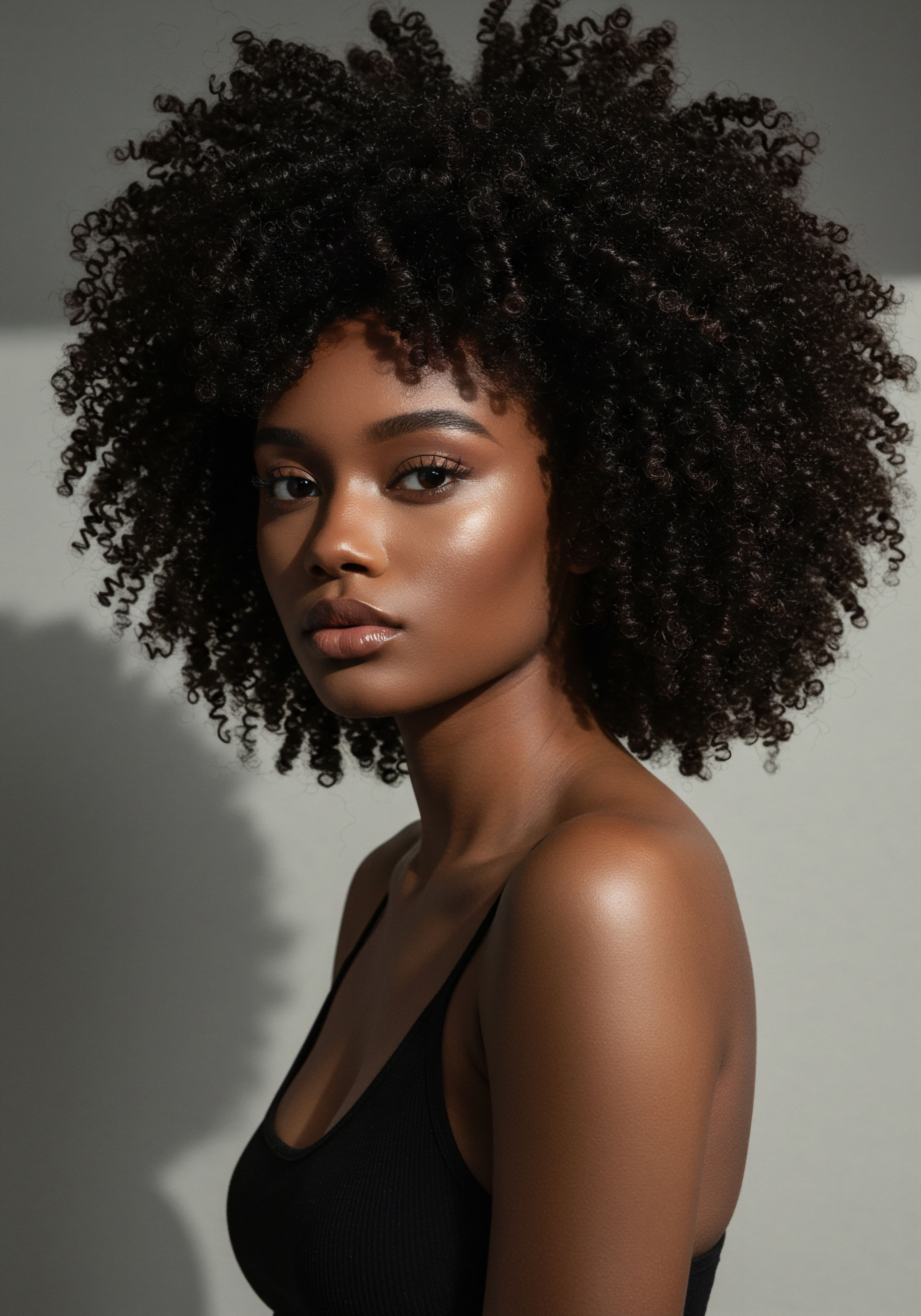
How do Braids Protect Hair from Breakage?
Braids, a prevalent form of protective styling, function by several mechanisms to reduce breakage. Firstly, they minimize daily manipulation, which is a significant cause of mechanical damage for coily hair. Each time hair is combed or styled, it undergoes tensile stress. For coily hair, the force required for combing can be significantly higher—a study indicates it may require 5 to 50 times the combing force of straight hair.
By placing hair in braids, this daily stress is greatly reduced. Secondly, braids physically shield the hair from external elements like wind, sun, and even friction from clothing, which can dry out or snag delicate strands. Thirdly, the grouped strands within a braid distribute tension more evenly than individual strands, reducing localized stress points that could lead to fracture. This allows the hair to rest and retain its length, as breakage is minimized, contributing to the perception of growth.

Natural Styling and Definition Techniques
Traditional African hair care also embraces natural styling techniques that work with the hair’s inherent curl pattern, rather than forcing it into unnatural shapes. Techniques like finger coiling, twisting, and Bantu knots enhance natural definition while minimizing heat and chemical intervention. The scientific basis for these methods lies in manipulating the hydrogen bonds within the hair’s keratin structure. Hydrogen bonds are temporary bonds that break when hair is wet and reform as it dries.
By shaping the hair while wet (e.g. twisting or coiling), these bonds reform in the desired pattern as the hair dries, locking in the definition without permanent alteration.
Moreover, these techniques often incorporate emollients and humectants. Natural oils and butters, commonly used in traditional practices (such as shea butter or coconut oil), serve as occlusives, creating a barrier on the hair surface to prevent moisture loss. Humectants, like glycerin (often found in natural plant extracts), draw moisture from the air into the hair, further aiding hydration. This combination supports the hair’s moisture balance, making it more pliable and less prone to breakage during styling.

Wigs and Hair Extensions Mastery
While sometimes viewed as modern additions, the concept of adding hair for protective or aesthetic purposes has roots in African traditions. Wigs and extensions, when applied correctly, can serve as powerful protective tools. They encapsulate the natural hair, shielding it from environmental exposure and daily manipulation, similar to other protective styles. The scientific consideration here revolves around application and removal.
Improperly installed extensions or wigs that create excessive tension at the scalp can lead to Traction Alopecia, a form of hair loss caused by prolonged pulling on the hair follicles. Therefore, the scientific principle guiding their use emphasizes minimal tension and proper scalp hygiene to preserve follicular health.

Heat Styling and Thermal Reconditioning Safety
The application of heat to coily hair requires particular caution due to its delicate structure. While traditional practices often relied on minimal heat or indirect methods, modern adaptations may include thermal reconditioning. From a scientific perspective, excessive heat can cause irreversible damage to the hair’s keratin proteins, leading to a loss of elasticity, increased porosity, and ultimately, breakage. The high internal lipid content in African hair, while beneficial for some properties, does not fully protect against the denaturing effects of extreme heat.
When heat is applied, water within the hair fiber rapidly vaporizes, causing internal structural changes. This process, known as “bubble hair,” can create voids and weaken the strand. Therefore, if heat is used, scientific principles advocate for:
- Temperature Control ❉ Using the lowest effective heat setting.
- Heat Protectants ❉ Applying products that form a barrier to distribute heat more evenly and reduce direct thermal impact.
- Moisture Balance ❉ Ensuring hair is adequately moisturized before heat application to prevent excessive drying and protein denaturation.
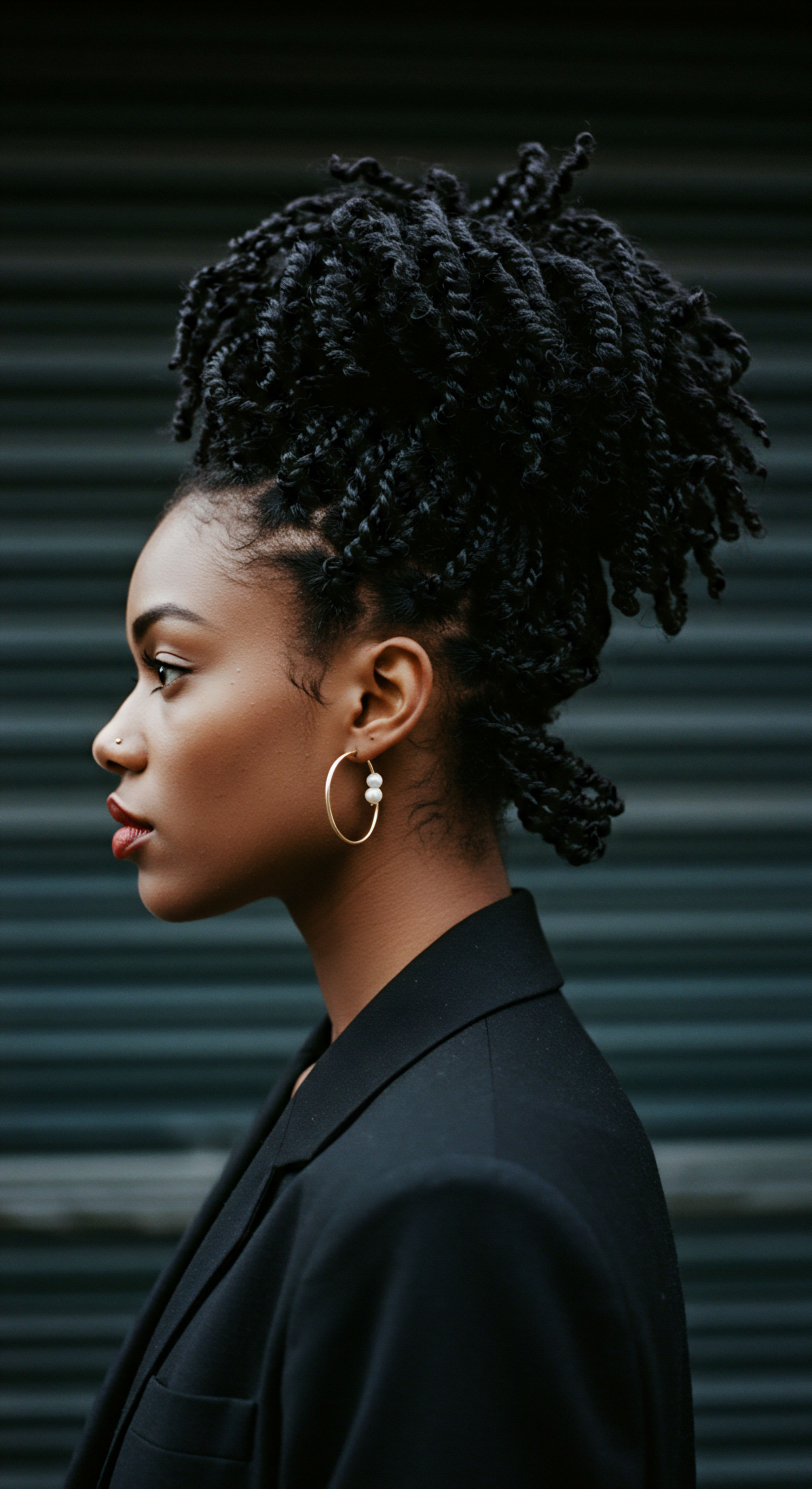
The Complete Textured Hair Toolkit
The tools used in traditional African hair care are often simple yet highly effective, aligning with the scientific needs of coily hair.
- Wide-Tooth Combs ❉ These are preferred over fine-tooth combs as they reduce friction and mechanical stress during detangling, minimizing breakage. The wider spacing allows coils to pass through more easily without snagging.
- Fingers ❉ Finger detangling is often considered the gentlest method, as it allows for tactile sensing of knots and tangles, enabling careful separation of strands. This direct contact reduces the likelihood of applying excessive force that could lead to breakage.
- Natural Materials ❉ Tools crafted from wood or bone often possess smoother surfaces than some plastics, further reducing friction and static electricity on the hair shaft.
The choice of tools directly influences the mechanical forces applied to the hair. Reducing the shear force and tensile stress during detangling is paramount for preserving the integrity of coily strands, which are inherently more prone to mechanical damage due to their unique geometry.
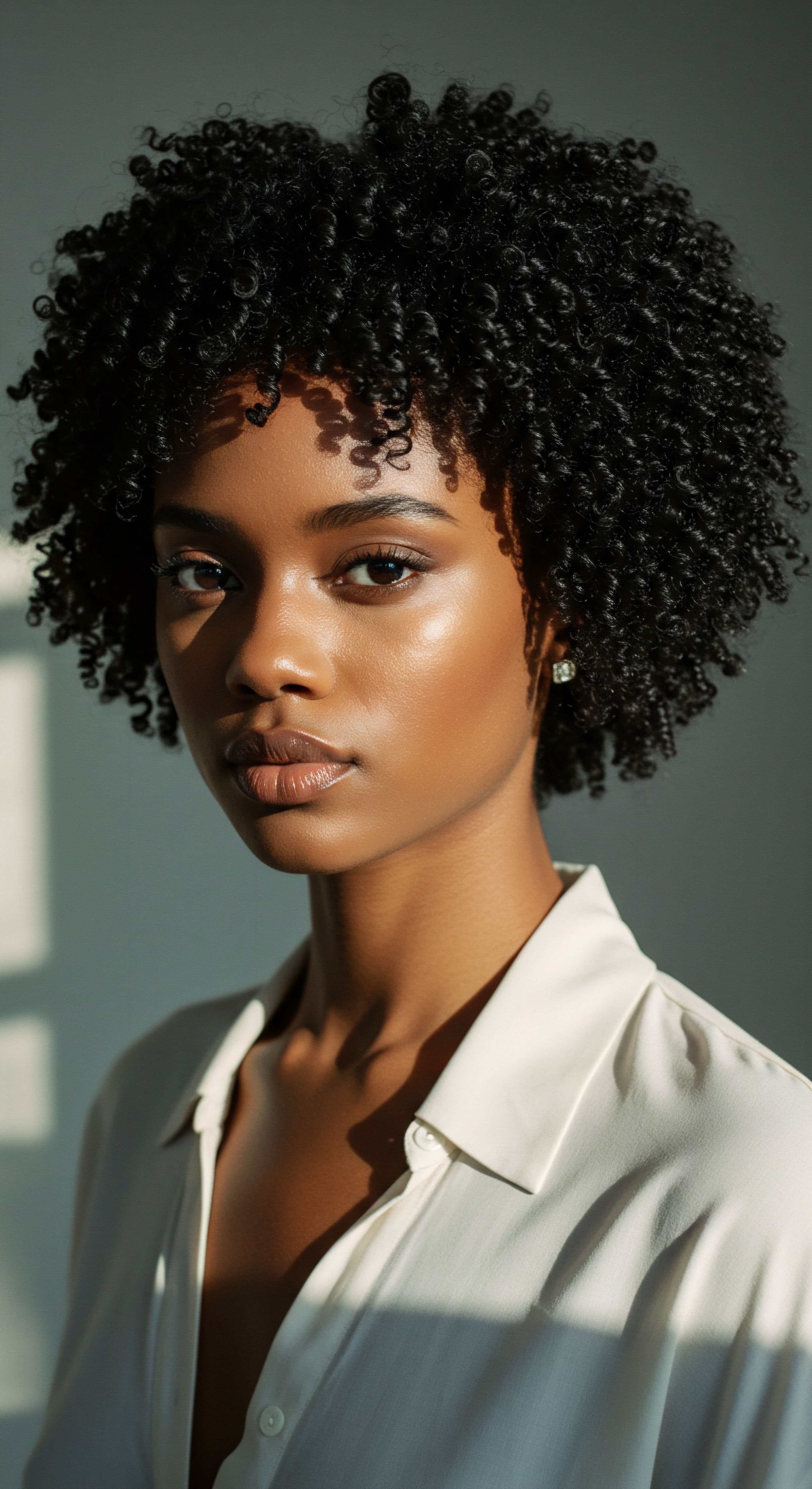
Relay
With an understanding of hair’s foundational science and the practical application of care, we now step into a deeper consideration ❉ the interconnectedness of scientific discovery, cultural practice, and personal well-being. This section transcends basic definitions, exploring the complex interplay that truly defines traditional African hair care. We will look at how ancient wisdom, often passed down through generations, finds surprising corroboration in modern scientific findings, revealing a sophisticated approach to hair health that is both deeply personal and universally resonant. We invite a more profound reflection on the synergy of body, plant, and spirit in maintaining vibrant, healthy coils.

Building Personalized Textured Hair Regimens
The concept of a personalized hair regimen, while a contemporary wellness buzzphrase, finds its roots in traditional African practices that inherently recognized individual differences in hair and scalp conditions. This intuitive understanding aligns with modern trichology, which acknowledges that hair porosity, density, and elasticity vary widely, even within similar curl patterns. A regimen grounded in scientific principles addresses these individual needs by selecting products and practices that support the hair’s unique moisture balance and protein requirements.
For instance, hair with High Porosity benefits from heavier creams and oils to seal in moisture, as its cuticles readily absorb and lose water. Conversely, Low Porosity hair requires lighter, water-based products to avoid product buildup, as its tightly closed cuticles resist moisture entry. Traditional practices often involved observation and adjustment, using different plant extracts or oil blends based on the hair’s response—a proto-scientific method of trial and adaptation.
The scientific literature increasingly supports the effectiveness of traditional plant-based ingredients. A review of African plants used in hair treatment and care identified 68 species, many with potential for addressing conditions like alopecia and dandruff, some even showing antidiabetic properties when taken orally. This suggests a deeper, systemic connection between topical application and overall wellness, moving beyond a single-target approach to a more holistic view of hair health.

Does African Traditional Hair Care Offer Systemic Health Benefits?
The question of whether traditional African hair care practices extend beyond cosmetic benefits to systemic health is a compelling one, gaining traction in modern research. Many traditional remedies for hair and scalp conditions utilize plants known for their medicinal properties when ingested or absorbed topically. For example, ethnobotanical studies identify plants used for hair care, such as Pterocarpus erinaceus or Artemisia afra, which also possess properties relevant to glucose metabolism or anti-inflammatory effects.
This suggests a potential link between the nutritional content of these plant extracts and their topical application, possibly influencing local cellular health, including the hair follicle. While more targeted research is needed to fully delineate these systemic connections, the historical use of these plants for overall well-being alongside hair care hints at a deeper, interconnected approach to health.

The Nighttime Sanctuary ❉ Essential Sleep Protection and Bonnet Wisdom
Nighttime care, particularly the use of head coverings like bonnets or scarves, is a long-standing tradition in African hair care, underpinned by sound scientific reasoning. During sleep, hair is susceptible to friction against bedding materials like cotton, which can be absorbent and rough. This friction can lead to tangles, breakage, and the absorption of moisture from the hair, exacerbating dryness in already fragile coily strands.
Silk or satin bonnets provide a smooth, low-friction surface that allows hair to glide freely, minimizing mechanical stress and preserving the curl pattern. This reduces the need for extensive detangling and restyling in the morning, which in turn reduces further manipulation-induced damage. Furthermore, these materials are less absorbent than cotton, helping the hair retain its natural moisture and applied products, thereby preventing excessive dryness and the subsequent risk of hygral fatigue. This simple ritual, passed down through generations, offers a profound protective measure for hair health.
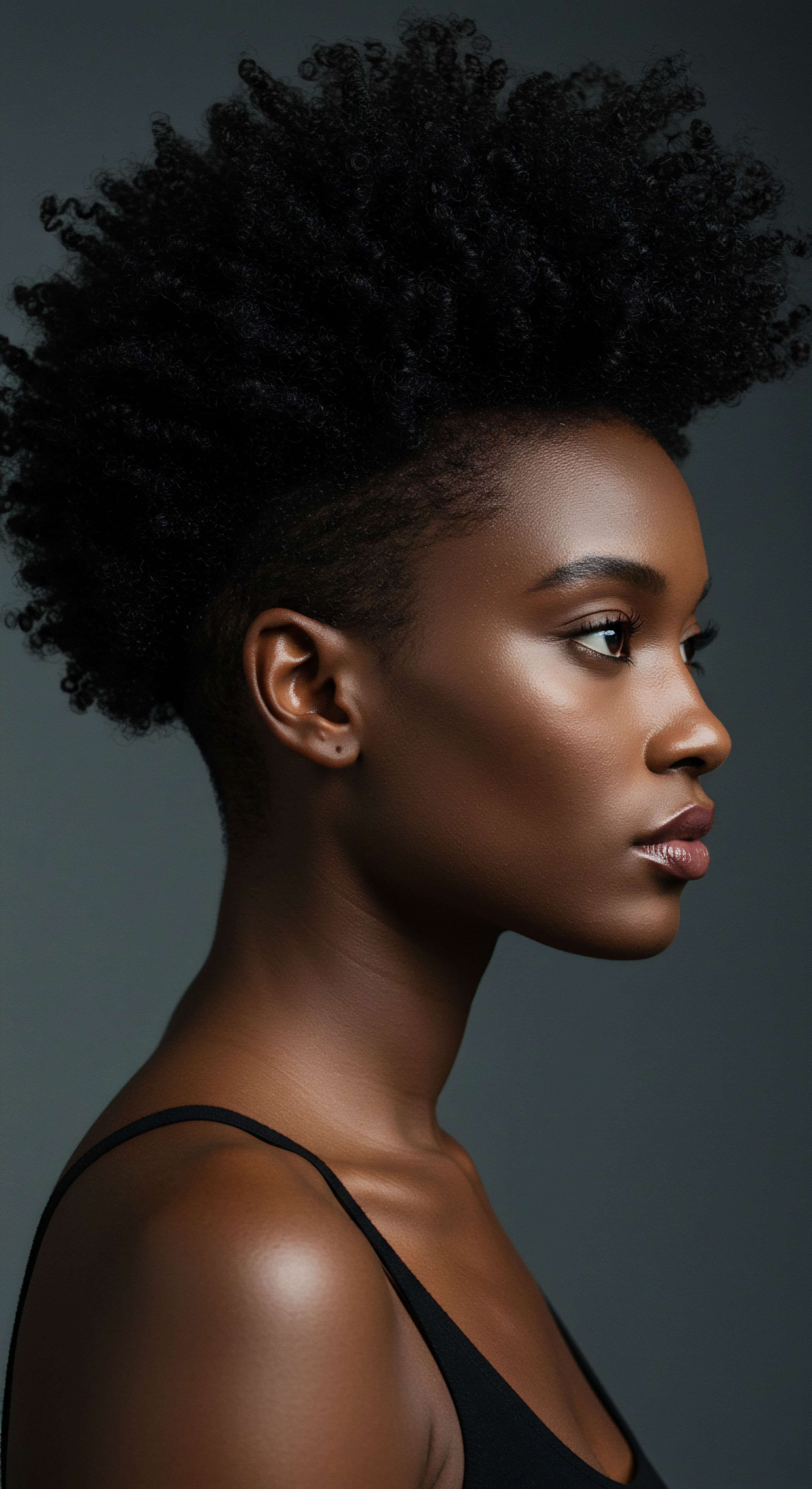
Ingredient Deep Dives for Textured Hair Needs
Traditional African hair care is rich in natural ingredients, each with specific scientific benefits that cater to the unique needs of coily hair.
- Shea Butter ❉ Derived from the nuts of the African shea tree, Shea Butter is a rich emollient, high in fatty acids and vitamins A and E. Scientifically, its occlusive properties form a protective barrier on the hair shaft, reducing transepidermal water loss and sealing in moisture, which is crucial for preventing dryness in coily hair.
- Chebe Powder ❉ Originating from Chad, Chebe Powder (Croton gratissimus) is a blend of natural ingredients known for its ability to strengthen hair and promote length retention. Its purported benefits stem from its ability to lubricate the hair, making it more pliable and less prone to breakage, thus preserving length. While direct scientific studies on Chebe’s mechanism are still emerging, its traditional use points to a physical conditioning effect that reduces friction and mechanical stress.
- Baobab Oil ❉ Extracted from the seeds of the African baobab tree, Baobab Oil is rich in omega fatty acids, particularly Omega-3, -6, and -9. These fatty acids are known to nourish the hair shaft, contributing to elasticity and shine. Its lightweight nature allows it to penetrate the hair cuticle, providing conditioning without excessive residue.
- African Black Soap ❉ Traditionally made from the ash of plantain skins, cocoa pods, and shea tree bark, African Black Soap is a gentle cleanser. Its mild surfactant properties allow for effective cleansing of the scalp and hair without stripping away too much of the hair’s natural lipids, maintaining the delicate moisture balance of coily hair.
These ingredients, used for centuries, reflect an intuitive understanding of lipid science and hydration principles, providing external lipids and moisture to compensate for the natural challenges of sebum distribution in coily hair.

Textured Hair Problem Solving Compendium
Addressing common textured hair concerns through a scientific lens often mirrors the wisdom embedded in traditional African remedies.
- Dryness and Breakage ❉ The high propensity for dryness in coily hair, due to its structure hindering sebum distribution, leads directly to increased breakage. Traditional solutions, heavily reliant on rich oils, butters, and consistent moisturizing routines, align with the scientific need to supplement the hair’s natural lipid barrier and maintain hydration. This combats the physical vulnerability of dry hair, which is more rigid and susceptible to fracture under mechanical stress.
- Scalp Health and Dandruff ❉ A healthy scalp is the foundation for healthy hair. Traditional African medicine frequently employed plant extracts with anti-inflammatory, antifungal, and antibacterial properties to address scalp conditions like dandruff or infections. Modern science confirms that many such plants, like Neem (Azadirachta indica) or certain types of African plants identified in ethnobotanical studies, possess these bio-active compounds that regulate scalp microbiota and reduce irritation. For instance, an overgrowth of the fungus Malassezia is a primary cause of dandruff, and certain plant extracts can help manage its proliferation.
A significant, yet often overlooked, aspect of hair health in individuals of African descent is the prevalence of specific forms of alopecia. Central Centrifugal Cicatricial Alopecia (CCCA), a scarring hair loss condition, and Traction Alopecia, caused by prolonged tension on hair follicles, are disproportionately observed in this population. While traditional practices may not have had the modern medical terminology, the emphasis on gentle handling, loose protective styles, and scalp care (often involving soothing herbal applications) inherently mitigated the risk of these conditions.
For example, a 2017 study published in the Journal of the American Academy of Dermatology found that Traction Alopecia was Observed in 34.8% of African American Women, a rate significantly higher than in other populations, directly correlating with certain styling practices that apply excessive tension. This statistic underscores the scientific imperative behind traditional advice to avoid overly tight styles and to prioritize scalp well-being.

Holistic Influences on Hair Health
Traditional African hair care extends beyond topical applications, recognizing a holistic connection between internal health and external vibrancy. This aligns with contemporary scientific understanding that diet, stress, and overall well-being significantly impact hair growth and quality. Nutritional deficiencies, for example, can manifest as hair thinning or weakened strands. Traditional diets, rich in nutrient-dense plant foods, often supplied the vitamins, minerals, and proteins necessary for healthy hair protein synthesis.
The emphasis on natural ingredients, often locally sourced, also meant a reduced exposure to synthetic chemicals that can sometimes irritate the scalp or compromise hair integrity. This integrated approach, where physical care, nutrition, and even spiritual connection to self and heritage are intertwined, forms a comprehensive framework for hair health that modern science is only beginning to fully quantify.

Reflection
As we step back from the intricate details of science and tradition, a profound truth settles ❉ the wisdom of African hair care, long practiced and passed down, stands as a testament to deep observation and a reverence for the body’s natural rhythms. It is a quiet dialogue between the human hand and the inherent needs of each strand, a conversation spanning generations. This rich legacy offers more than just techniques; it presents a philosophy of care, a gentle reminder that true beauty often lies in working with, rather than against, our natural design. The scientific principles we uncover today merely affirm what our ancestors understood intuitively ❉ that care born of connection and respect yields enduring radiance.
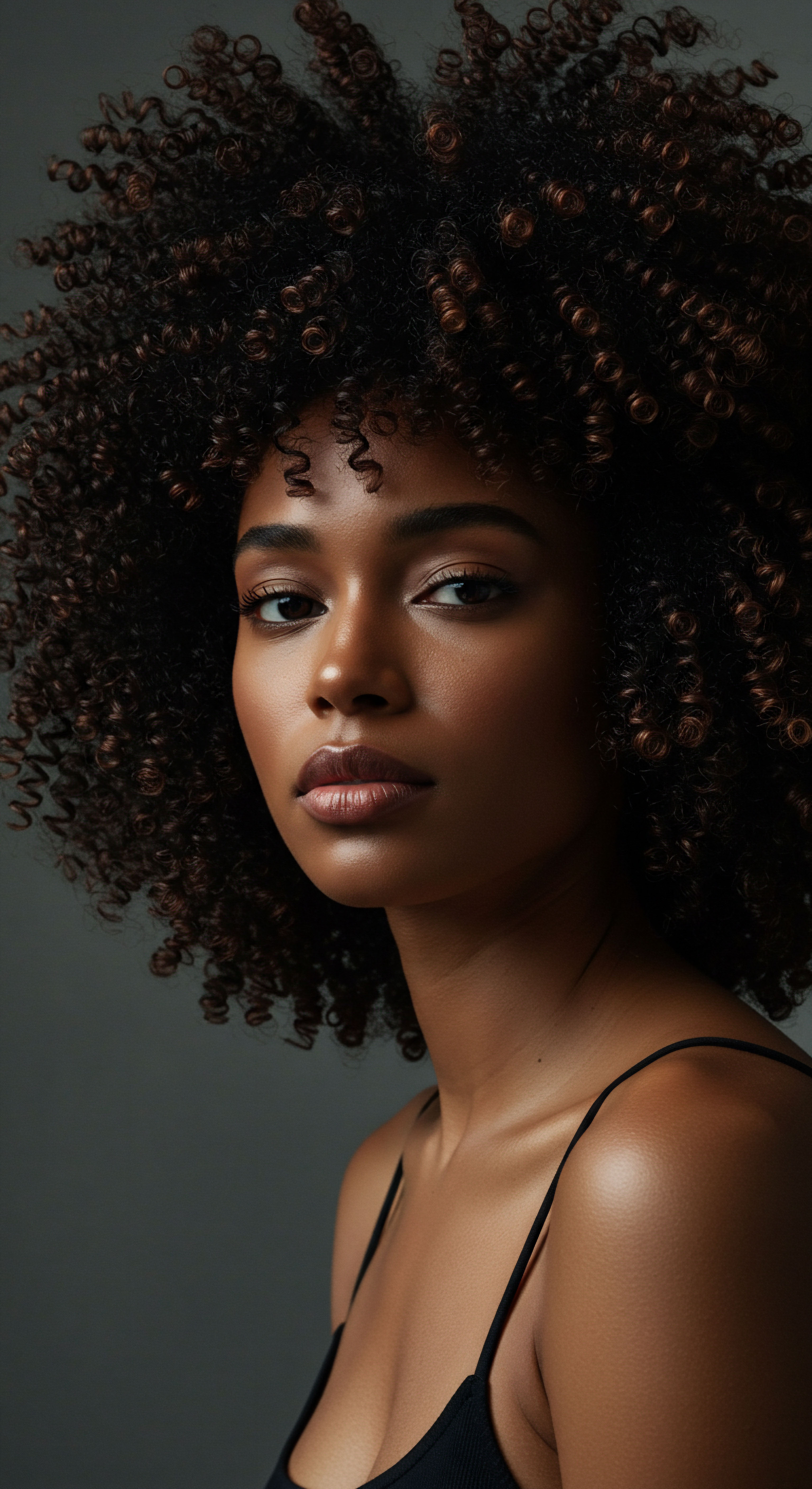
References
- Adeyemi, O. K. et al. “A Review Of Indigenous Therapies For Hair And Scalp Disorders In Nigeria.” International Journal of Pharmaceutical Sciences Review and Research 77.2 (2024) ❉ 1-10.
- Gaines, M. “New ways to measure curls and kinks could make it easier to care for natural hair.” American Chemical Society. (2023).
- Gaines, M. et al. “The Science of Curly Hair Typing.” CurlsBot. (2025).
- Khumalo, N. P. et al. “What is normal black African hair? A light and scanning electron-microscopic study.” Journal of the American Academy of Dermatology 43.5 (2000) ❉ 814-820.
- Loussouarn, G. et al. “Hair aging in different races and ethnicities.” Journal of Cosmetic Dermatology 20.2 (2021) ❉ 401-409.
- Loussouarn, G. et al. “The influence of hair lipids in ethnic hair properties.” International Journal of Cosmetic Science 28.5 (2006) ❉ 331-338.
- Mboumba, M. E. et al. “Cosmetopoeia of African Plants in Hair Treatment and Care ❉ Topical Nutrition and the Antidiabetic Connection?” Diversity 16.2 (2024) ❉ 96.
- Nanda, S. et al. “The Genomic Variation in Textured Hair ❉ Implications in Developing a Holistic Hair Care Routine.” Cosmetics 10.4 (2023) ❉ 92.
- Okereke, I. et al. “Dispelling The Myths from the Facts around Hair Loss in Black Women.” UK Hair Consultants. (2023).
- Perrin, A. et al. “Keratins and lipids in ethnic hair.” Journal of Cosmetic Science 58.3 (2007) ❉ 275-282.
- Randall, V. A. et al. “The hair growth cycle.” Nanogen. (2021).
- Robbins, C. R. Chemical and Physical Behavior of Human Hair. Springer Science & Business Media, (2012).
- Rogers, C. E. et al. “Hair Breakage in Patients of African Descent ❉ Role of Dermoscopy.” Skin Appendage Disorders 6.1 (2020) ❉ 23-28.
- Rodrigues, L. “Understanding Hygral Fatigue and its Impact on Curly Hair.” Pattern Beauty. (2024).
- Soufi, Z. et al. “Ethnobotanical Survey of Medicinal Plants used in the Treatment and Care of Hair in Karia ba Mohamed (Northern Morocco).” E3S Web of Conferences 444 (2024) ❉ 02008.
- Verma, S. et al. “Porosity and Resistance of Textured Hair ❉ Assessing Chemical and Physical Damage Under Consumer-Relevant Conditions.” Cosmetics 10.3 (2023) ❉ 74.